Thesis
There are over a billion websites worldwide competing with each other for attention as of 2024. On average, a user will spend 52 seconds on a website. This has driven businesses across all sectors to prioritize their web presence, recognizing that regular content updates and engaging design are essential for success in the digital age.
The demand for web development services surged as a result. In the US there were 218K front-end developers in 2023, with 60% believing that cross-platform applications are the future of web development. This includes applications that work across different operating systems, and devices. Some industry experts estimate that 95% of online content could effectively be served through front-end platform-as-a-service environments, reducing the need for complex back-end infrastructure for many websites. The rise of cross-platform complexity is driving demand for more agile, composable web development solutions that can integrate with existing toolchains and emerging technologies such as personalization systems, ERP platforms, and various ad services.
Vercel is positioning itself at the forefront of this evolving landscape as a cloud-based platform for building, previewing, and deploying user-facing applications. According to Guillermo Rauch, the founder of Vercel, the company’s vision is to become “an end-to-end platform where all software development on the web happens, from idea to production through getting your analytics on what to improve next, to the next idea.” The company's approach aligns with the growing trend towards more efficient, front-end-focused web development practices, potentially addressing the needs of businesses across various sectors looking to establish and maintain a modern, performant web presence.
Founding Story
Vercel was founded in 2015 by Guillermo Rauch (CEO), Tony Kovanen (Vercel’s ex-CTO), and Naoyuki Kanezawa.
The company was initially called Zeit before rebranding in April 2020 to Vercel. Prior to founding Vercel, Rauch and Kovanen were the co-founders of Next.js, an open-source web development framework used to build static and dynamic websites. Rauch had also been the founder of Socket, a real-time communication library for real-time web applications, instant messaging, and real-time analytics.
In addition, before Vercel, Rauch was the CTO and co-founder of LearnBoost and Cloudup. Automattic acquired Cloudup in 2013 for an undisclosed amount. Beyond being a major contributor to Socket in 2011, Rauch co-authored mongoose Node.JS in 2012 and contributed to MongoDB, ODM, Node.JS, and MooTools.
Prior to co-founding Vercel, Kanezawa worked with JavaScript for over nine years and had been a core contributor to Socket and Engine.io. Socket is a JavaScript event-driven library for real-time web applications. Notable companies using Socket include Microsoft Office, Yammer, Trello, and Zendesk.
Tony Kovanen was the CTO of Vercel from its founding in December 2015 to August 2017. Before Vercel, he was a JavaScript Developer at Automattic with Guillermo. After Vercel, Kovanen worked at Iglu, Gatsby Inc., Saulx, Based.io, and as an independent developer. As of September 2024, he is the CTO of an early-stage crypto startup called Token Terminal.
Product

Source: Vercel
Vercel is built around several technologies that have had significant implications for how web applications are built including JAMstack, edge compute, and serverless technologies. Jamstack is an architecture that aims to make the web faster, more secure, and easier to scale using serverless. Serverless design allows developers to run and build web apps without having to manage the underlying servers.
The standard web development process includes research, design, creating content, development, beta testing, review, quality assurance, launch, and maintenance. Deployment takes ~12 to 28 weeks, or even longer for large sites.
Every website includes a front end and a back end. The front end directly interfaces with the user and leverages the backend for data once the user clicks or makes any request on a website. The backend handles the core data, logic, API, and database architecture. Vercel’s product provides the core infrastructure for the front end, but it also provides the elements required for the back end. Vercel’s product stack is meant to be end-to-end, in that it addresses functionality around developing, previewing, and deployment for developers.
AI
Vercel provides tools for deploying AI applications compatible with various frameworks including React, Next.js, Vue, Nuxt, and SvelteKit.

Source: Vercel
The AI SDK is divided into two pillars: UI and core. The company’s UI pillar offers framework-agnostic hooks for chat, completion, and assistants that enable developers to build functional chatbots with minimal code.
In May 2024, Vercel acquired ModelFusion.dev, expanding the AI SDK's capabilities beyond UI with the launch of AI SDK 3.1. Vercel considers this its core pillar, which provides a unified API that abstracts the complexities between different AI providers. The toolkit supports various AI providers such as OpenAI, Anthropic, Hugging Face, Azure, Amazon Bedrock, Google, Mistral, Groq, Perplexity, Fireworks, Cohere, LLama, and Ollama. All the supported models are available in their AI Playground, which allows developers to compare performance for specific tasks. A switch between model providers in Vercel’s AI SDK happens by changing a single line of code in the API.
Previews

Source: Vercel
Vercel Previews is a collaborative development and deployment platform. It was designed to streamline the process of pushing, reviewing, and iterating on code changes before deployment to production. This command center consolidates various tools and functionalities essential for development workflows.
The platform integrates with major version control systems, including GitHub, Bitbucket, GitLab, and Azure DevOps, while also offering a command-line interface (CLI) for direct interactions. When developers push code to a connected repository, Vercel automatically generates a preview deployment, combining staging and environment setup to provide an instant, live view of the changes. This supports an iterative development approach, allowing teams to push and test frequent, small updates with ease.
To enhance control over new feature releases, Vercel Previews supports the implementation of feature flags for gradual rollouts and A/B testing. In case there are issues, the platform offers quick rollback functionality to revert to a previous stable version, reducing potential disruption to the development process. Leveraging edge computing technology, Vercel deploys previews with low-latency access for users worldwide. A notable feature of the platform is its bidirectional sync capability, where changes made in the preview environment, including modifications to CMS content, can be automatically pushed back into the main codebase. This ensures that all changes are captured in the version control system, maintaining a single source of truth for both code and content throughout the development lifecycle.
Rendering
In May 2023, Vercel expanded its offerings by introducing back-end services, providing clients with a serverless architecture for web applications. This infrastructure is designed to automatically detect and optimize deployments for over 40 frameworks, including popular choices such as JavaScript, TypeScript, Tango, Elixir, and Go. Vercel manages the necessary compute resources across 18 regions worldwide.
To enhance performance, Vercel has built its own Content Delivery Network (CDN) on top of hyperscaler infrastructure. This proprietary CDN integrates with Vercel's routing and dispatch logic, which is particularly optimized for the Next.js framework. The platform offers flexible deployment options, allowing users to deploy multiple versions of their site simultaneously and intelligently route users to the correct version at runtime.
Vercel Rendering offers an isolated bridge to on-premise backends or services, enabling clients to use a secure integration with existing infrastructure while leveraging Vercel's global deployment capabilities. Their serverless solution allows developers to focus on building applications while Vercel handles the complexities of deployment, scaling, and global distribution.
Observability
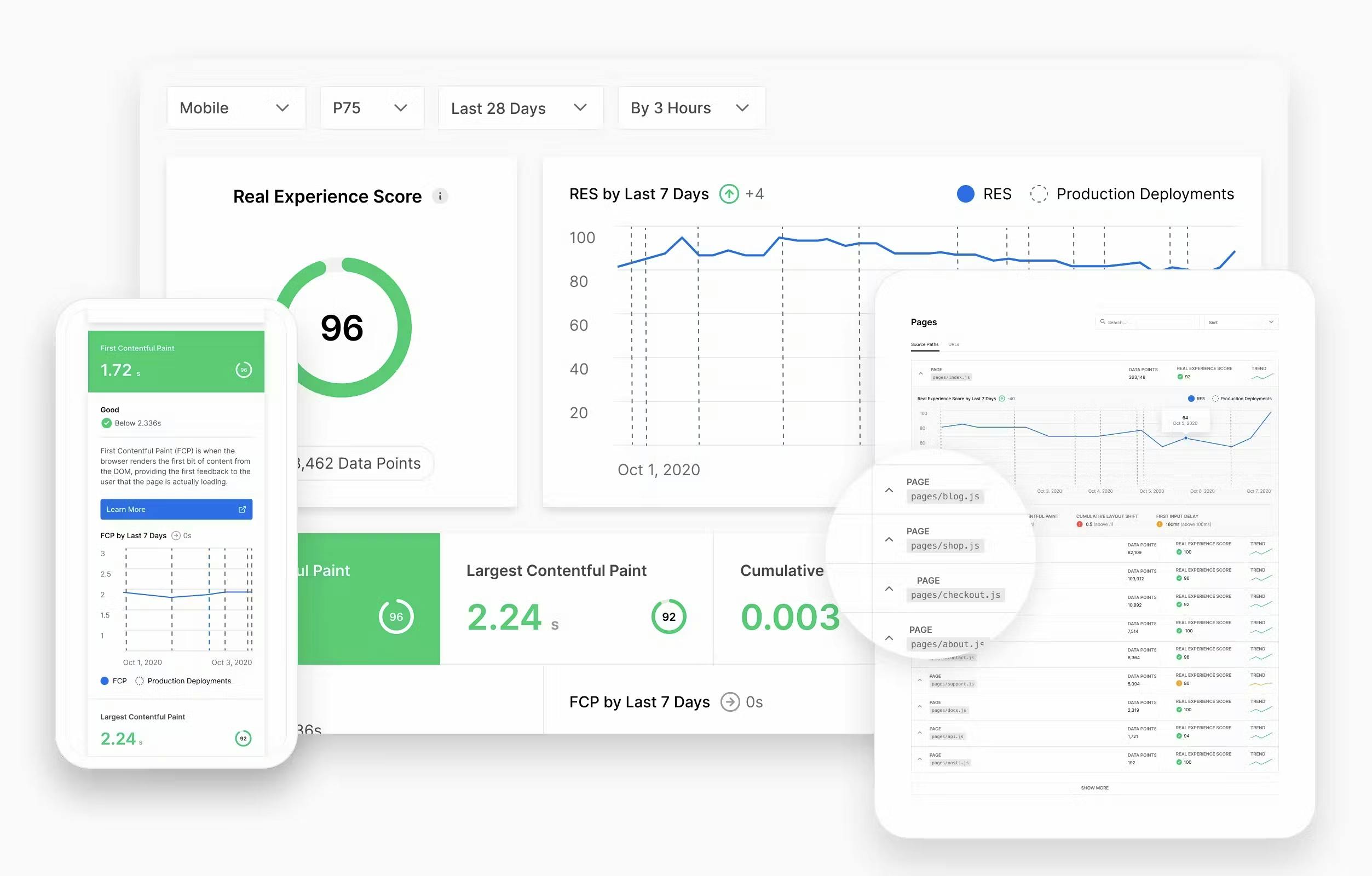
Source: Vercel
In October 2022, Vercel announced the acquisition of Splitbee, an analytics and conversion tool that enables their clients to understand the experience users go through on their site. Splitbee’s functionality was integrated into Vercel’s Observability dashboard. First-party data is collected through the domain, helping to avoid ad blockers and providing developers with a clearer picture of their audience.
Vercel's dashboard serves as a hub for real-time infrastructure and traffic insights. Developers can leverage this platform to detect and diagnose application issues, analyze performance metrics, and run queries. It provides insights for diagnostics, performance optimization, bandwidth analysis, and bot detection. The centralization of runtime logs generated by Vercel's infrastructure across all environments enhances the platform's ability to provide a holistic view of application performance.
Recognizing the diverse needs of its users, Vercel implemented analytics integrations that allow data to be sent to third-party systems. This provides more advanced analysis, alerting capabilities, and seamless integrations with existing monitoring and analytics stacks. By offering this flexibility. Teams can maintain their preferred workflows while benefiting from the platform's native capabilities.
By consolidating these critical functions, Vercel aims to reduce the complexity of managing multiple tools and platforms, allowing developers to focus more on innovation and less on operational overhead.
Next.js
As a native Next.js platform, Vercel offers out-of-the-box support for Next.js and React applications, requiring no additional configuration. This integration forms the foundation of Vercel's DX Platform, specifically designed to empower front-end developers to ship faster, more efficient user interfaces. Vercel’s Next.js integration contains a suite of tools and optimizations that enhance the development workflow, streamlining the process from code creation to deployment.
At the core of Vercel’s platform is Next.js's approach to routing. By leveraging the file system for route creation, Next.js simplifies the development process while supporting advanced routing patterns and UI layouts. This system boosts developer productivity while promoting better code organization, resulting in more maintainable and scalable applications. Next.js enables developers to build APIs directly within Vercel’s applications, eliminating the need for separate API services.
Vercel's platform also focuses on performance optimization through its support for server-side rendering (SSR). This feature enables faster initial page loads.
For content-heavy websites, such as those in retail, consumer packaged goods, media, and blogging, Vercel's implementation of Static Site Generation (SSG) offers advantages. By pre-rendering and automatically caching generated pages, and then distributing them across Vercel's Edge Network, SSG enhances both performance and SEO. This approach is particularly beneficial for sites with a large amount of static content that don’t require frequent updates.
Recognizing the need for dynamic content updates without compromising the benefits of static generation, Vercel's Next.js platform includes Incremental Static Regeneration (ISR). This feature allows for content updates from a Content Management System (CMS) without necessitating a full site redeployment. ISR strikes a balance between the performance benefits of static generation and the flexibility of dynamic content, enabling websites to stay current and relevant while maintaining optimal loading speeds and SEO advantages.
Security
Vercel offers a security suite designed to safeguard applications deployed on its platform. With six certifications including ISO 27001, SOC 2, PCI DSS, HIPAA, GDPR, and DPF, Vercel demonstrates its commitment to maintaining high standards across various industries and regulatory frameworks.
At the core of Vercel's security offering is its DDoS mitigation system, powered by the Vercel Firewall. This system provides real-time threat monitoring, API request frequency control, and a custom rule engine for tailored security policies. Firewall changes are implemented across Vercel's global network within 300 milliseconds, ensuring rapid response to emerging threats.
For Enterprise clients, Vercel offers a managed ruleset for OWASP Top 10 protection, guarding against the most common web application security risks. Vercel's security measures are implemented at the edge networks, providing threat mitigation without adding latency to applications. The platform also offers private and dedicated environments, allowing for enhanced security through isolation of resources and data. To ensure continuous operation, Vercel implements automatic failovers, routing traffic to the nearest available region in the event of an outage. Additionally, static assets are replicated and cached across the network, contributing to uptime and availability.
Vercel's Security product extends to code management, allowing for the establishment of code owners to ensure appropriate individuals are responsible for reviewing and approving changes to specific parts of the codebase. This addresses concerns from network-level attacks to code-level vulnerabilities and access control. The edge-based implementation of security features allows for threat mitigation while maintaining optimal performance.
Turbo
Turbo, a collaborative development environment made possible by Vercel’s acquisition of Turborepo in December 2021, is designed to streamline the development process for monorepos. This tool enables teams to work within a single repository containing multiple projects or applications, addressing the unique challenges of monorepo structures.
At the heart of Turbo's functionality is its project analysis system. By automatically determining the correct build order based on inter-project dependencies, Turbo optimizes the development workflow from the start. Vercel enhances this capability with parallel execution, allowing build tasks to run simultaneously.
One of Turbo’s features is its remote caching capability. This system automatically shares build artifacts among team members, reducing duplicate work. When a developer completes a build, Turbo stores the resulting artifacts in a remote cache. Subsequent builds by other team members can then retrieve these cached artifacts instead of rebuilding from scratch, leading to time savings and efficiency across the entire development team.
To help teams quantify the benefits of using Turbo, Vercel provides performance-tracking tools. These analytics offer insights into time saved, cache performance, and build speed improvements, allowing teams to measure and optimize their development processes continually.
As a part of the Vercel ecosystem, Turbo integrates with other Vercel products and services. Projects built with Turbo can be deployed to Vercel's hosting platform without additional configuration, streamlining the path from development to production. Furthermore, Vercel's global edge network can automatically cache and serve static assets generated by Turbo builds.
v0
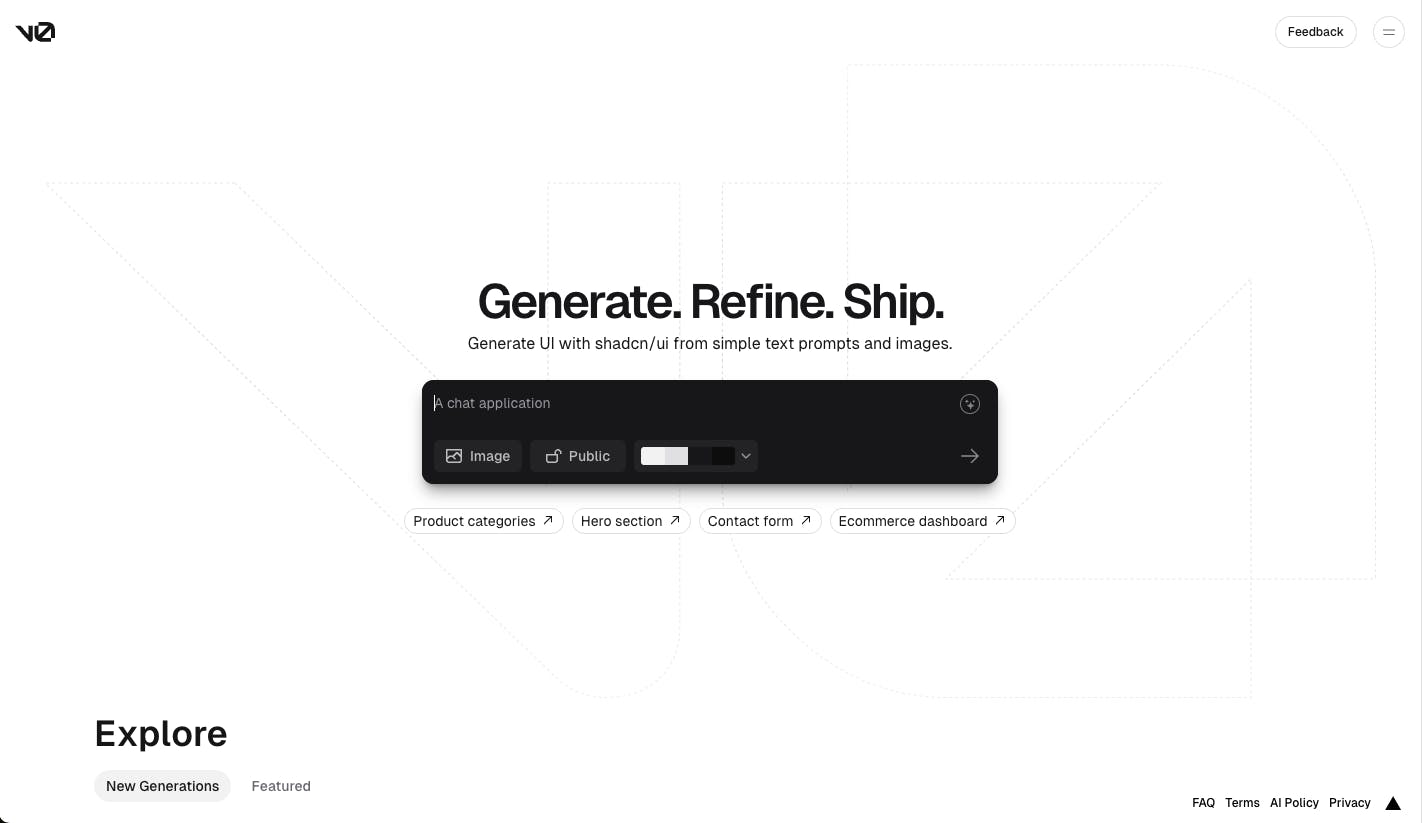
Source: Vercel
v0 is Vercel's generative UI design tool that transforms prompts or images into functional React components with Tailwind CSS, bringing each generation to life with client-side JavaScript. The platform aims to streamline the process of creating user interfaces by leveraging AI to generate code that developers can use in their projects. It’s primarily used for prototyping, design inspiration, code generation, and learning.
At its core, v0 allows users to input a prompt describing their desired UI component or upload an image as a reference. The system then generates three different UI design options based on the input. Users can select individual parts of the designs for more precise adjustments through the v0 chat. It provides developers with a way to debug, answer development questions, and generate more code after the initial prompt.
v0 includes a feature that allows users to explore UI components generated by other users. This community-driven aspect serves as inspiration and can speed up the design process by leveraging existing ideas.
Vercel emphasizes that v0's AI models are trained on a mix of custom code written by their team, open-source datasets, and synthetic data. The company explicitly states that no Vercel customer data or code has been, is being, or will be used to train, improve, or fine-tune v0.
Enterprise
Vercel Enterprise is designed to help large organizations focus on shipping features instead of managing infrastructure. It integrates with clients' existing git workflows and scales automatically with traffic, allowing companies to maximize their web development capabilities without requiring a full-stack team.
By abstracting away complex infrastructure management, Vercel allows developers to plug and play with the latest web technologies. The platform supports easy integration with modern frameworks, headless CMS systems, and serverless databases.
Vercel Enterprise was designed to enable less technical users, such as marketing content creators, to contribute to web projects without depending on engineering resources.
Market
Customer

Source: Vercel
Vercel makes products for front-end developers working at agencies, SMBs, and enterprises. A former employee said the company shifted its sales focus in 2023 from individual developers and engineering directors to department heads like CTOs, CIOs, and CMOs due to economic contractions. Vercel simplifies the deployment process, with a particular focus on customers within the JavaScript and TypeScript ecosystem.
In terms of large enterprises, Vercel powers the websites for companies like Walmart, Apple, Nike, Netflix, TikTok, Uber, Lyft, and Starbucks. The platform serves companies across the commercial and retail, consumer packaged goods (CPG), online retail, media, and brand content industries.
Market Size
The global public cloud services market is projected to reach $805 billion in 2024 and double in size by 2028, growing at a five-year CAGR of 19.4%. The three largest industries - banking, software and information services, and retail - are expected to represent $190 billion in public cloud services spending in 2024.
Platform-as-a-Service (PaaS) and Infrastructure-as-a-Service (IaaS) each account for nearly 20% of all public cloud spending in 2024. PaaS is projected to be the fastest-growing category, with data management software leading. Artificial intelligence platforms within PaaS are expected to experience the fastest growth with a five-year CAGR of 51.1%.
The US is anticipated to be the largest public cloud services market, with spending expected to exceed $432 billion in 2024. In markets like the US, 91% of people use the internet and engage daily with online applications. The serverless market, a subset of cloud services particularly relevant to Vercel's offerings, is projected to reach $36 billion by 2028.
Competition
Front-end developers can leverage a number of different tools to create their websites. For static websites with incremental updates, people will often use no-code website builders like Webflow or Squarespace. But for dynamic applications that are more complex, and require a developer to be able to more closely manage scaling, performance, and updates, web developers focus on front-end platforms instead. The market can be broadly categorized into front-end-centric deployment, traditional deployment, and hybrid deployment solutions.
Front-End Centric Deployment
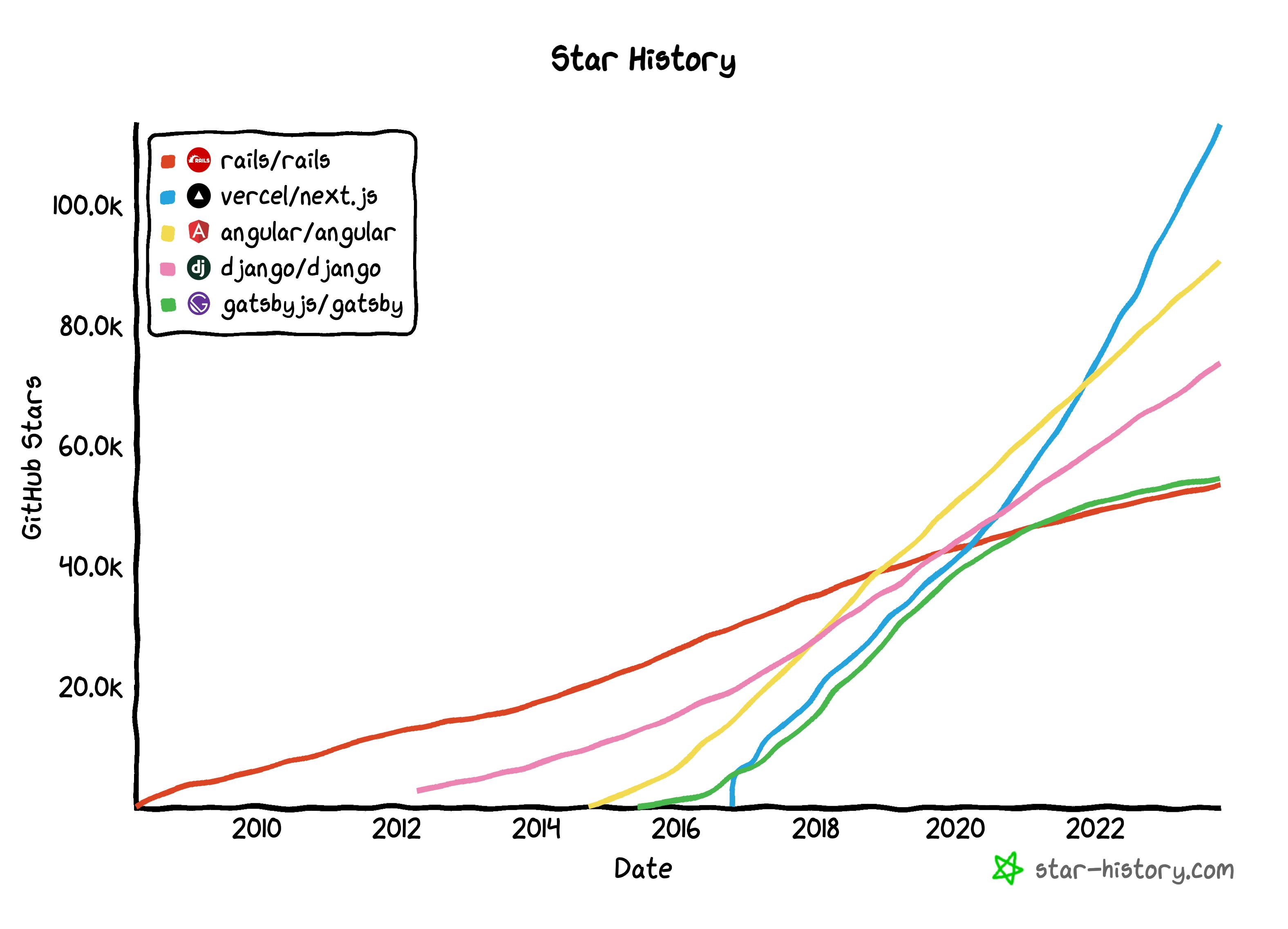
Source: Star History
Netlify: Founded in 2014, Netlify is a cloud platform that simplifies the process of building, deploying, and managing modern web projects. As of September 2024, it had raised $212.1 million over seven funding rounds and was valued at $2 billion as of 2021 from Kleiner Perkins, Bessemer Venture Partners, a16z, and HubSpot Ventures. Netlify offers a suite of tools and services for developers, including continuous deployment, serverless functions, and a global content delivery network. The company has made acquisitions like Stackbit and parts of Gatsby to enhance its offerings. Netlify tends to be more framework-agnostic and caters to a broader, more mature market compared to Vercel. A former Vercel employee said Netlify aims for an 80% traditional developer, 20% non-developer user base, but is rapidly shifting towards capturing more of the non-traditional developer market.
Cloudflare Pages: Cloudflare, founded in 2009, is primarily a CDN-focused company that has expanded into the web development space with Cloudflare Pages. As a public company, Cloudflare reported $1.3 billion in revenue for 2023. Cloudflare has an advantage in WebAssembly (Wasm) deployment, which allows for deploying various programming languages optimized for edge environments. While Vercel uses Cloudflare for its edge functions, Cloudflare's own offerings compete directly with Vercel in this space.
Traditional Deployment
Heroku: Founded in 2007 and acquired by Salesforce in 2011 for $212 million, Heroku was the first product in the Platform-as-a-Service (PaaS) category. It provides a fully managed container-based environment with integrated data services, allowing developers to focus on writing code rather than managing infrastructure. Heroku supports a wide range of programming languages and focuses more on backend services compared to Vercel's front-end specialization.
AWS ECS: Launched in 2014, Amazon Elastic Container Service (ECS) is a fully managed container orchestration service that allows easy deployment, management, and scaling of containerized applications on AWS. While ECS provides more granular control and deep integration with other AWS services, it lacks the streamlined, developer-friendly experience that Vercel offers for frontend and serverless deployments.
Hybrid Deployment
Fly.io: Founded in 2017, Fly.io represents a middle ground between traditional PaaS and front-end-focused platforms. As of September 2024, it had raised $115 million over five funding rounds and was valued at $450 million as of 2023 from notable investors like a16z, Intel Capital, Dell Technologies Capital, and Y Combinator. Fly.io allows developers to deploy applications globally without managing complex infrastructure, offering a network of data centers that run containerized apps close to end users. This approach provides low-latency performance and easy scaling across multiple regions, differentiating it from Vercel's primary focus on frontend and serverless deployments.
Generative User Interfaces
Figma: While not a direct competitor in the deployment space, founded in 2012, Figma is worth mentioning due to its advancements in AI-generated UI layouts. Figma's AI capabilities allow for the generation of UI layouts and design mockups based on text prompts as of June 2024, competing with the frontend development process that Vercel caters to with v0.
Business Model
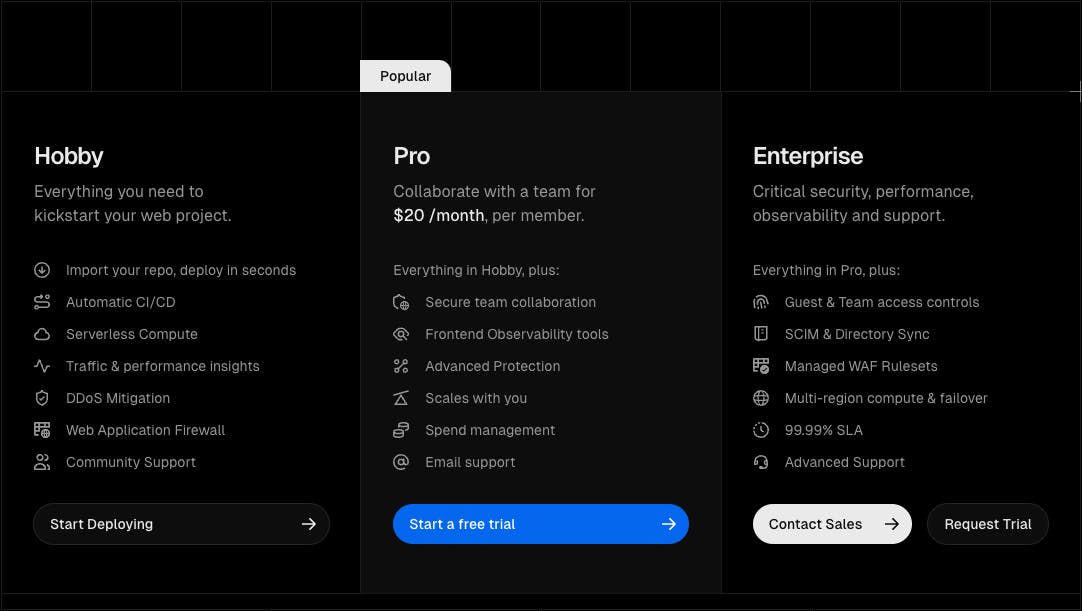
Source: Vercel
Vercel has both a freemium and an open-source business model. It monetizes by offering a hosted serverless platform for front-end applications. There are three key product categories:
Hobby: Vercel has an open-source software named “Hobby” which is a free product it uses to acquire customers to test the platform.
Pro: These are subscriptions that are $20 per user/month. This is Vercel’s core offering.
Enterprise: These are custom solutions and pricing for larger enterprises which is not public, but they provide companies with more cybersecurity features and advanced speed capabilities.
This pricing structure supports a land-and-expand product-led growth (PLG) strategy, with a significant portion of sales coming from inbound leads. The company's margins are reported by a former employee to be around 70%.
In addition to its core platform, Vercel has introduced v0, an AI-powered developer tool. v0 follows a similar freemium model:
Free: Allows users to explore the tool with limited credits
Premium: $20 per month with an option to purchase more credits for generation
Enterprise: Custom pricing based on usage
The v0 Premium plan is separate from the Vercel Pro plan. For example, a user with a Vercel Pro team (one member at $20) and a v0 Premium plan ($20) would pay a total of $40 per month.
Traction
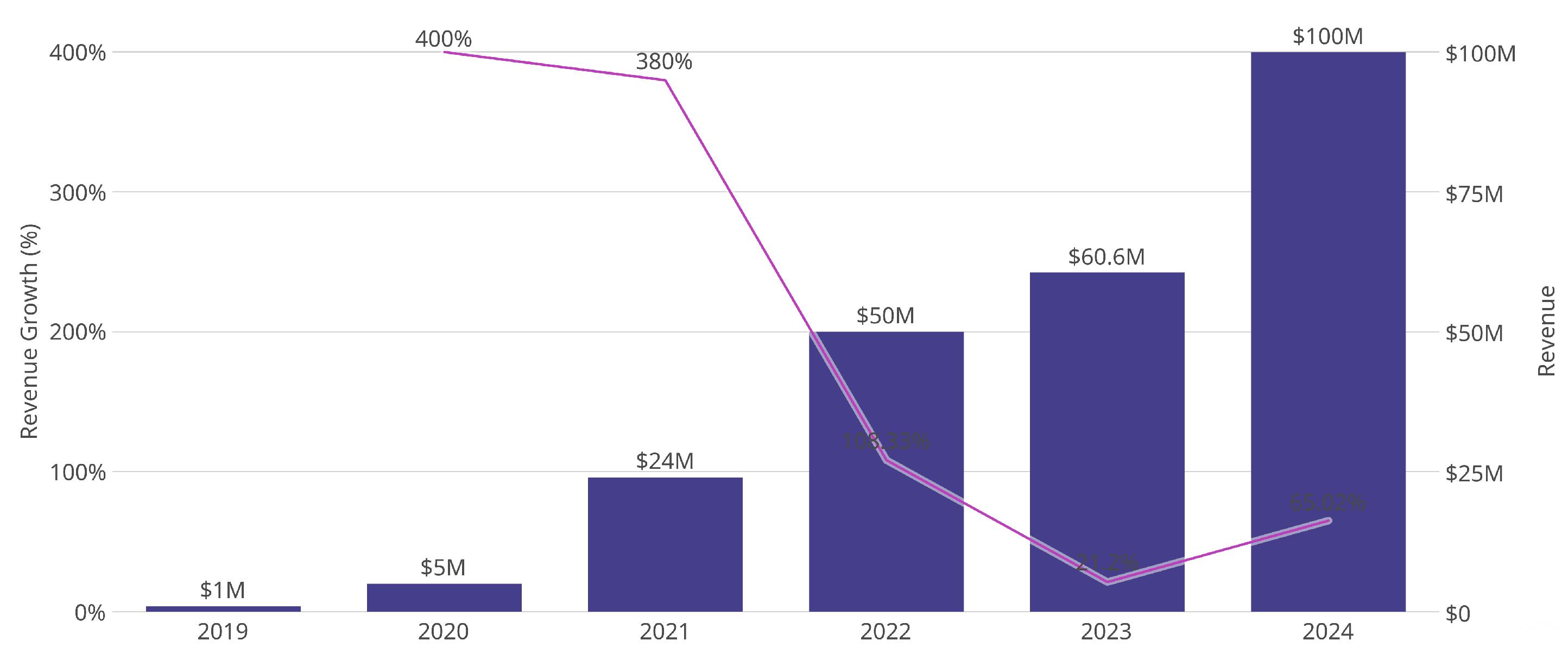
Source: ApeVue
In a June 2023 interview, Guillermo Rauch shared that Vercel grew in revenue from $1 million in 2019 revenue to $5 million in 2020. By June 2023, the company was at $50 million in revenue. In March 2024, Vercel surpassed $100 million in ARR. At the announcement of its Series C funding round in June 2021, Vercel had seen significant growth in traffic to all sites and apps on its network, nearly doubling from October 2020. The number of sites among the world’s largest 10K websites that use Next.js grew 50% in the same time frame between 2020 and 2021.
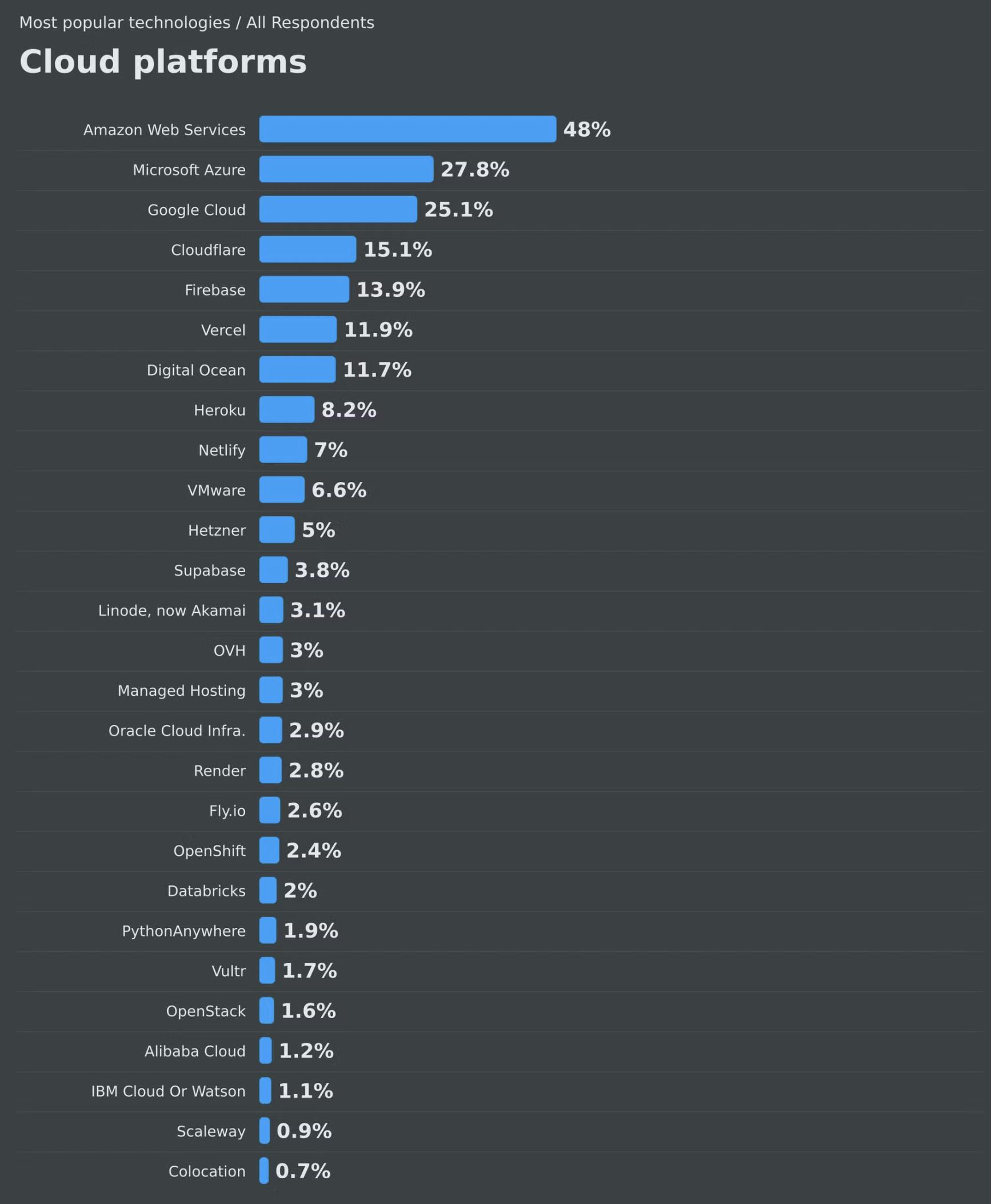
Source: Stack Overflow
Given Vercel’s management of the Next.js framework, Vercel sees an increase in growth when more developers use Next.js. The company’s user base has grown to over a million software developers using its Next.js technology monthly in May 2024. The company's freemium model attracts approximately 100K new sign-ups each month in 2024.
From April 2020 to May 2023, the number of websites powered by Next.js grew from 35K to 4 million including the websites of companies like Walmart, Apple, Nike, Netflix, TikTok, Uber, Lyft, and Starbucks. As of June 2023, Vercel’s technology is downloaded 200 million times per week and is managing 30 billion requests per week. A year later, Vercel’s security product mitigated nearly a billion security threats weekly from the request to their clients’ websites. In 2023, the company had also partnered with numerous leaders in the serverless and digital experience spaces, such as Neon and Sitecore.
In the eight months following its launch, Vercel's v0 AI-powered design tool has been used to generate 3 million unique user interfaces.
Valuation
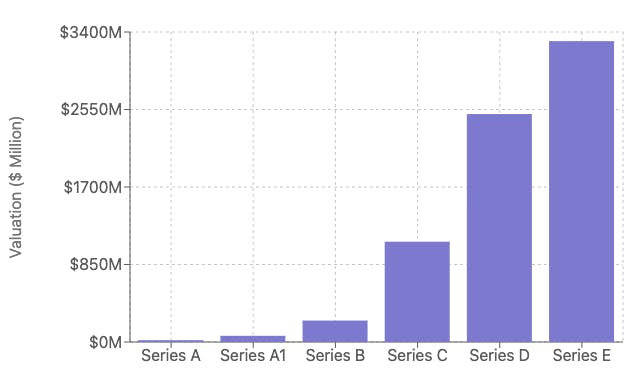
Source: PitchBook
In May 2024, Vercel raised a $250 million Series E round led by Accel, with participation from Tiger Global Management and Google Ventures, valuing the company at $3.3 billion. This brought Vercel's total funding to $563 million. Previous investors included Bedrock, Greenoaks, Tiger Global, 8VC, and individual investors like Nat Friedman (CEO of GitHub), Jordan Walke (Creator of React), and Matias Woloski (Founder/CTO of Auth0). As of September 2024, Vercel's valuation on secondary markets has risen slightly to $3.4 billion.
Key Opportunities
Expanded Infrastructure Product Suite
In May 2023, Vercel announced Vercel Firewall and Vercel Secure Compute to expand the platforms’ capabilities in terms of ensuring the security of a customer’s websites. Similarly, in October 2023, Vercel announced a spend management product to help developers track how much they spend on infrastructure. Serverless infrastructure provided by Vercel can scale up and down depending on the applications needed, but this can often exceed the available budget of the customer. This additional functionality allows customers can take more control over their own infrastructure.
Additional security and cost management features allow Vercel to build a more expansive set of infrastructure offerings. As web development continues to move towards scalability, performance, and cross-platform, the ability to bundle as much infrastructure in one platform as possible can be a critical opportunity for Vercel.
Serverless Computing
Guillermo Rauch, Vercel’s CEO, pivoted from using servers to serverless computing to remove complexity and simplify developers' work. Serverless allows developers to build and run code without managing servers and paying for unused cloud infrastructure. In addition to cost savings, serverless makes it easy to scale applications without developers making extra configurations, compared to Platform-as-a-Service (PaaS). Cloud service providers like Amazon Web Services (AWS Lambda), Microsoft Azure (Azure Functions), Google Cloud (Google Cloud Functions), and IBM Cloud (IBM Cloud Code Engine) also offer serverless offerings.
Expanding to Non-Developer Users
Vercel has an opportunity to capture a larger market share by making its platform more accessible to non-traditional developers. In 2023, a former employee estimated the company's user base is 75% traditional developers and 25% non-developers. By continuing to develop and improve collaborative editing environments and marketer-friendly tools, Vercel can attract more non-technical users and expand its total addressable market. This shift aligns with industry trends, as competitors like Netlify are also moving in this direction. Vercel's early entry into this space with its collaborative editing environment and v0 positions it to capitalize on this opportunity.
Design-Centric Approach
Vercel's heavy focus on design, with three distinct design teams: brand creative, product design, and design engineering, presents an opportunity to differentiate itself in the market. By leveraging design as an essential resource, Vercel can create more intuitive and visually appealing products that cater to both technical and non-technical users. This design-centric approach could be a key factor in attracting and retaining customers, especially as the company expands its reach to non-traditional developers who may place a higher value on user experience and aesthetics.
Key Risks
Technological Shifts in Web Development
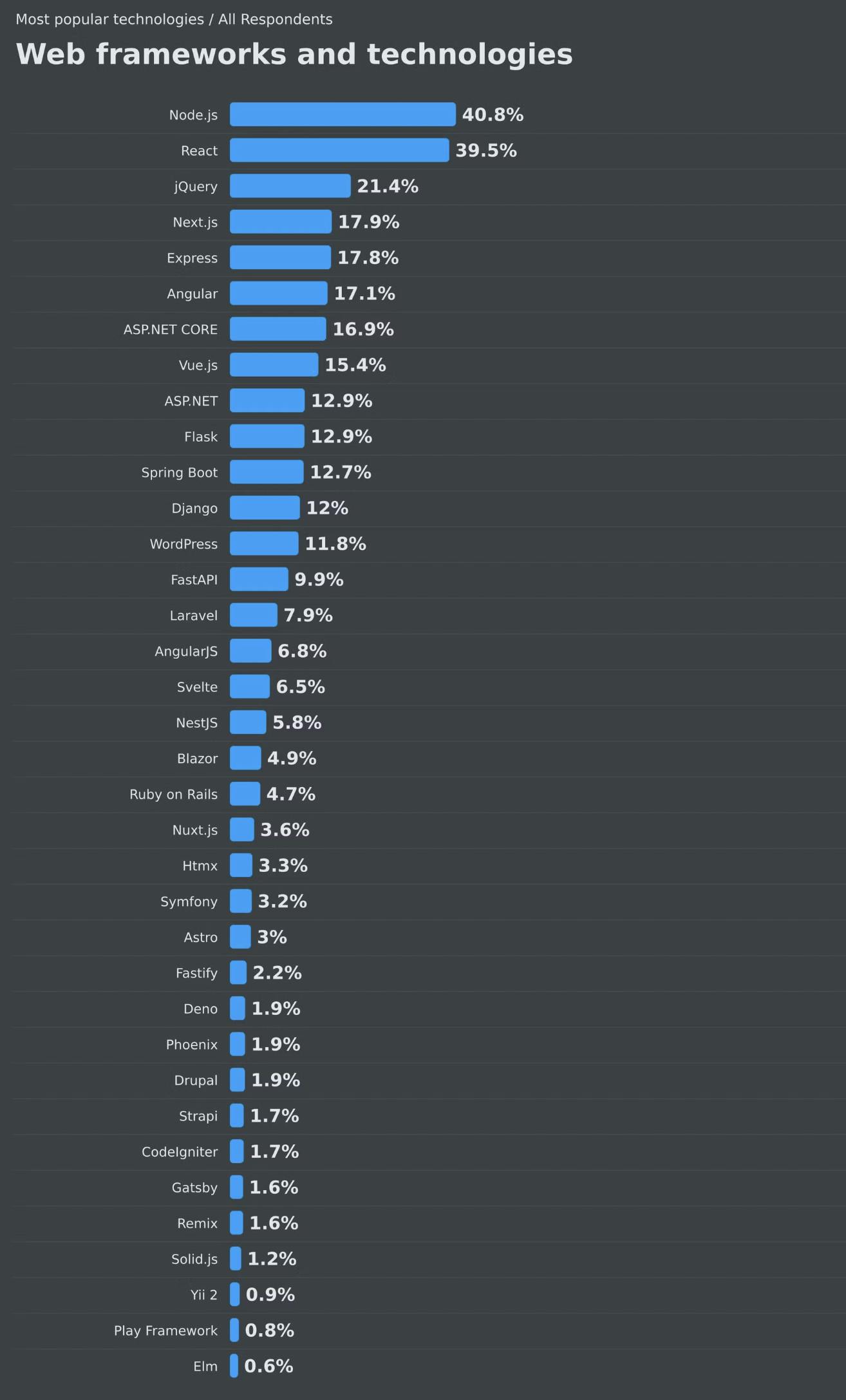
Source: Stack Overflow
Full-stack web frameworks like Django and Ruby on Rails were popular before front-end frameworks like React and Vue.js took over. React gained popularity in 2017 due to its simplicity and flexibility. The growth of Vercel has been somewhat dependent on the growth of the React and Next.js frameworks. If developers begin favoring a simpler alternative to Next.js, it would be a negative for Vercel.
Competition in the PaaS Market
Vercel faces intense competition in the Platform-as-a-Service (PaaS) market from companies like Netlify. These companies are vying for dominance in the developer ecosystem, employing high-cost acquisition strategies to capture market share. However, a former Vercel employee reported neither Vercel nor Netlify had achieved profitability as of 2023. As both Vercel and Netlify continue to evolve their platforms, Vercel must differentiate itself and demonstrate a clear path to profitability to maintain its competitive position.
Summary
Vercel is a cloud-based platform for building, previewing, and deploying front-end web applications. Founded in 2015, the company has focused on developer experience and performance optimization. Vercel's product suite includes AI-powered tools, enterprise solutions, and the popular Next.js framework. The company serves a wide range of customers from individual developers to large enterprises like Walmart and Netflix.
Vercel operates in the growing public cloud services market, which is projected to reach $805 billion in 2024. The company faces competition from both front-end-focused platforms like Netlify and traditional deployment solutions like Heroku. Vercel's business model combines freemium and open-source approaches, with revenue coming from Pro subscriptions and Enterprise solutions.
As of March 2024, Vercel surpassed $100 million in ARR and raised a $250 million Series E round in May 2024, valuing the company at $3.3 billion. Key opportunities include expanding its infrastructure product suite, capitalizing on serverless computing trends, and attracting non-developer users. However, Vercel faces risks from potential shifts in web development technologies and intense competition in the PaaS market.







